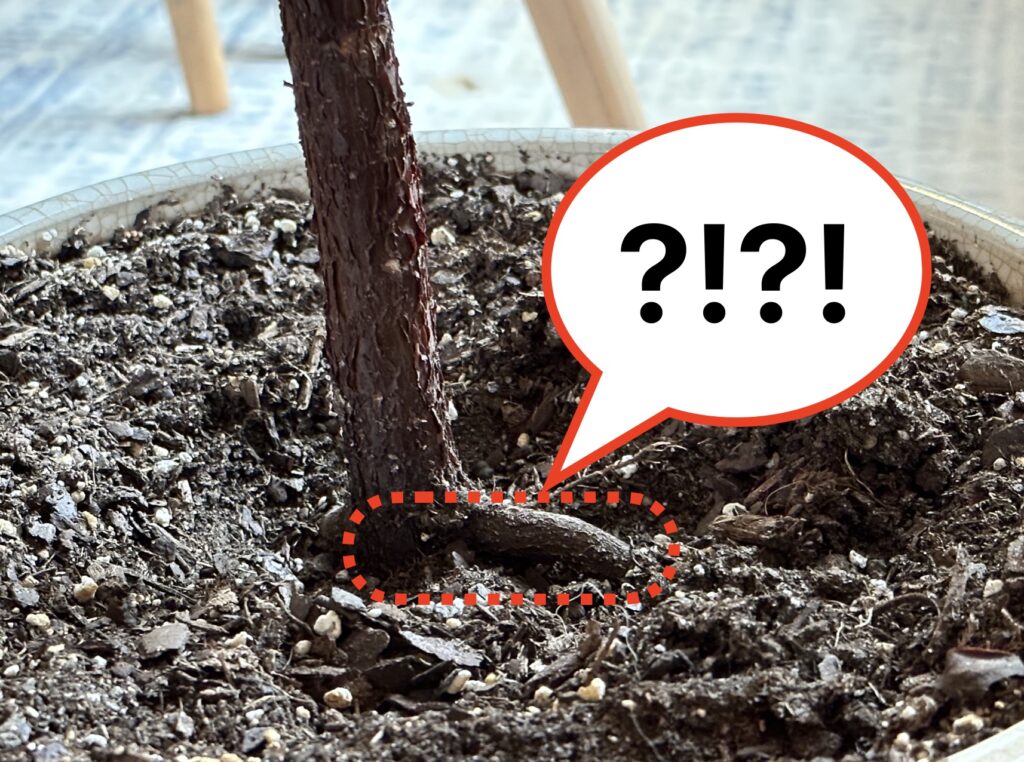Confession time: This winter, I haven’t paid much attention to my Fiddle Leaf Fig. Having it for a few years, I know it doesn’t grow during the winter months. While watering today, I noticed something: my Fiddle Leaf Fig has roots above the soil. After researching, I learned more about why this is happening, and why it’s nothing to panic about.
What is a Fiddle Leaf Fig?
Before jumping in, the Fiddle Leaf Fig – scientifically known as the Ficus lyrata – is a popular houseplant known for the massive fiddle-shaped leaves for which the plant is named. These trees get a bad reputation on being expensive and difficult, but after understanding its care needs, the Fiddle Leaf Fig makes a fantastic houseplant.
Would I recommend the Ficus lyrata as someone’s first houseplant? Probably not. But once someone can care for more entry-level plants like the Philodendron Brasil or Monstera Deliciosa, a Fiddle Leaf Fig may be the perfect next step.
Noticing Fiddle Leaf Fig roots above soil
Why do Fiddle Leaf Figs expose their roots above the soil? This is a common plant behavior. Like other woody trees, Fiddle Leaf Figs have both shallow and deep roots. Over time, the shallow roots may appear at the surface for a number of reasons.
Roots exposed from soil erosion
If you notice roots at the surface of your pot, it’s likely due to dropping soil levels.
This can occur if you let the soil dry out between waterings, causing the soil to erode more when you re-water your plant. Luckily, the fix here is simple and can benefit your Fiddle Leaf Fig.
Add more fresh soil to the top of the container. Gently compress the soil to help it keep its structure during waterings. If you noticed your soil was bone-dry when you first saw your Fiddle’s exposed roots, you may want to add more water more regularly. This promotes healthy plant hydration but will maintain a healthy soil level.
🌱How to Guide: Avoid accidentally introducing gnats with new soil >
Fiddle Leaf Fig aerial roots
If your Fiddle Leaf Fig has roots above soil, they are likely aerial roots. More common with vining plants, aerial roots on trees in the Ficus family help stabilize your plant at the soil level.
Aerial roots form over time. They are more likely to appear if your Fiddle Leaf Fig spends time outdoors, exposed to wind and breezes.
Exposure to these elements is beneficial to your plant. The natural motion of airflow catches the large leaves like massive sails, rocking the plant. This motion encourages stronger trunk growth. To strengthen the plant even more, the trunk develops aerial roots close to the surface to better anchor the plant in place.
Can I remove aerial roots from my Fiddle Leaf Fig?
Removing aerial roots from your Fiddle Leaf Fig is honestly more trouble than its worth.
While cutting aerial roots won’t directly impact your plant, any open lesion at the soil level introduces a way for infection to enter your plant, much like an open cut on a person. Cutting aerial roots means your plant loses stability from wind forces, and could make it weaker during a storm if kept outdoors in the summer.
I’d recommend keeping your plants aerial roots, potentially covering them with a fresh soil level if they bother you. Removing them could open your plant up to infection or make it weaker to the elements.
Why it’s natural if your Fiddle Leaf Fig has roots above soil
If your plant needs a fresh layer of soil or is sending aerial roots to grow stronger, it’s perfectly normal if your Fiddle Leaf Fig has roots above soil. It may need additional soil to cover up any exposed roots.
If it’s late winter or early spring, and you notice your plant may need a new pot to get ahead of the spring growing season, you can review our Fiddle Leaf Fig container guide. With the right care, your Fiddle Leaf Fig can grow into a massive, beautiful plant – exposed roots and all!

